Report

At a Glance
- Spain is seen as an energy transition leader, with renewables growth helping curb net emissions by 4.1% a year since 2016.
- But business-as-usual projections show Spain falling 40% short of where it needs to be to reach net zero emissions by 2050.
- The private sector will play a key role in helping Spain make up the shortfall.
- Companies must also invest in adaptation as the area of Spain subject to climate risks rises from 58% today to 79% in 2050.
Spain’s warm, sunny climate, traditionally a lure for tourists, is turning nasty. As of October 2023, 23 provinces had seen mercury climbing to never-before-seen highs, with yearly averages for Cuenca, Girona, and Granada a scorching 2.9 degrees Celsius above the mean from 1981 to 2010.
More than 2,000 people died of heat-related causes during a summer that had four heat waves. Ozone pollution reached dangerous levels, and the Canary Islands witnessed its worst wildfire in 40 years, destroying unique habitats on Tenerife.
The events were a grim reminder of how the planet is edging toward climate tipping points that scientists say could be catastrophic once global temperatures rise 1.5 degrees Celsius above pre-industrial levels.
This temperature increase was chosen as a red line in 2015 at the 21st Conference of the Parties in Paris and ratified by global leaders a year later, giving administrations a mandate to reduce emissions through energy system decarbonization while adapting to climate hazards.
Already, at 1.1 degrees Celsius, global temperatures are prompting questions over the effectiveness of government efforts to meet a Paris-agreed goal of net zero emissions by 2050.
Spain has keen interest in meeting this target. Part of the Mediterranean basin biodiversity hotspot—which means it is one of the most biologically rich areas on Earth—75% of the Iberian Peninsula is in danger of becoming a desert, according to conservation group the World Wide Fund for Nature.
Although the Spanish public and private sectors have taken admirable steps to head off a climate emergency, helping to cut nationwide emissions by 4.1% a year since the implementation of the Paris Agreement in 2016, Bain analysis shows the country could still fall short of its climate ambitions.
Global efforts to combat climate change
Governments, agencies, and corporations worldwide are working on multiple fronts to curb the rise in greenhouse gases.
Alongside the Paris Agreement, which built on a 1992 United Nations Framework Convention on Climate Change (UNFCCC) and the 1997 Kyoto Protocol, the UN introduced 17 Sustainable Development Goals in 2015.
That year also saw the introduction of the Science Based Targets initiative to help companies cut emissions in sync with climate science, followed by a Net-Zero Asset Owner Alliance in 2019.
More recently, administrations have looked to use emissions reduction as a tactic for economic growth, with the US launching its most ambitious clean energy support package, the Inflation Reduction Act, in 2022.
The EU, meanwhile, aimed to turbo-charge cleantech manufacturing with the European Green Deal in 2020 while seeking a 55% cut in emissions by 2030 under its 2021 Fit for 55 package.
Laudable progress on emissions reduction
Spanish government, corporations, and citizens have already managed to reverse annual net emissions growth in 15 years, taking it back to pre-1990 levels.
Spain cut its gross emissions from 326 million tons of carbon dioxide equivalent (Mt CO2e) at the ratification of the COP21 Paris Agreement in 2016 to 258 Mt CO2e at COP27 in 2022, continuing a downward trend that has been prevalent since 2005.
From 2005 to 2022, the country slashed its gross greenhouse gas emissions by around 42%, largely erasing the 52% rise it experienced from 1990 to 2005 (see also net emissions trend in Figure 1).
From 1990 to 2022, Spain reduced net emissions by meeting a 32% emission reduction target, although this falls short of the Paris Agreement’s expectation of 55%

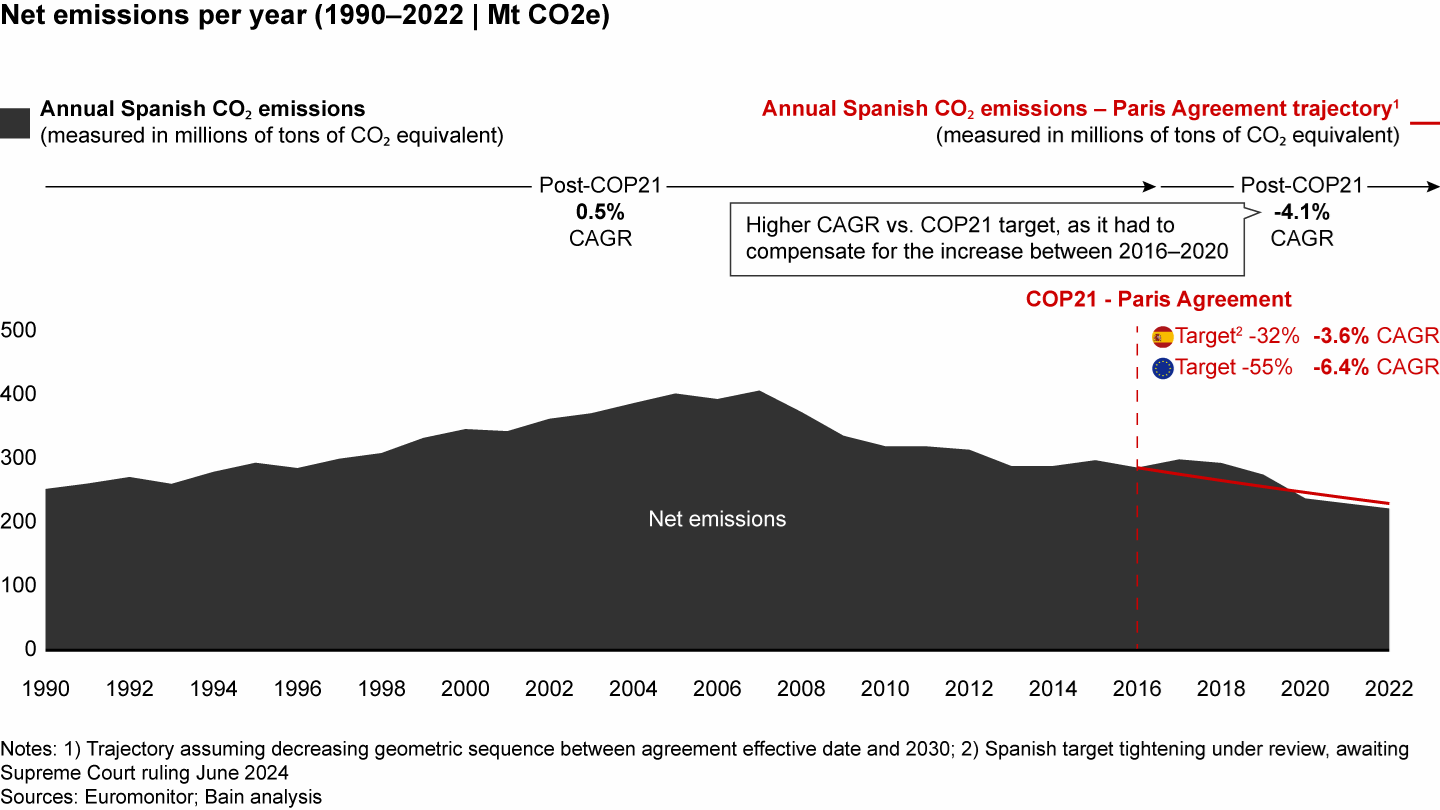
Around 47% of this reduction has come about through the decarbonization of power generation, initially as a result of coal plant closures and particularly from 2019 onward as Spain has enjoyed one of the highest annual renewable energy installation rates in Europe.
Manufacturing contributed a further 26% of the 184 Mt CO2e of gross emissions cuts from 2005 to 2022—and transport another 16%.
The Great Recession’s impact on Spanish industrial output initially drove this downward trend in emissions. It is laudable at a time when gross emissions globally, and in major economies such as China and India, are still rising (see Figure 2).
Compared to pre-industrial levels, gross greenhouse gas emissions have increased significantly, leading to higher global temperatures


However, it is far from enough to meet Europe’s Fit for 55 objectives. In Spain, the 55% reduction implies a negative CAGR of 6.4%.
But Spain’s 2030 net greenhouse gas reduction target, which is under review pending a June 2024 Supreme Court ruling, is 32%—a CAGR of -3.6%. Without greater ambition, this would leave Spain around 100 Mt CO2e short of its net zero target in 2050, a roughly 40% shortfall (see Figure 3).
Business-as-usual projections indicate a shortfall of ~100 Mt CO2e (~40% short of the target) for Spain to achieve net zero by 2050

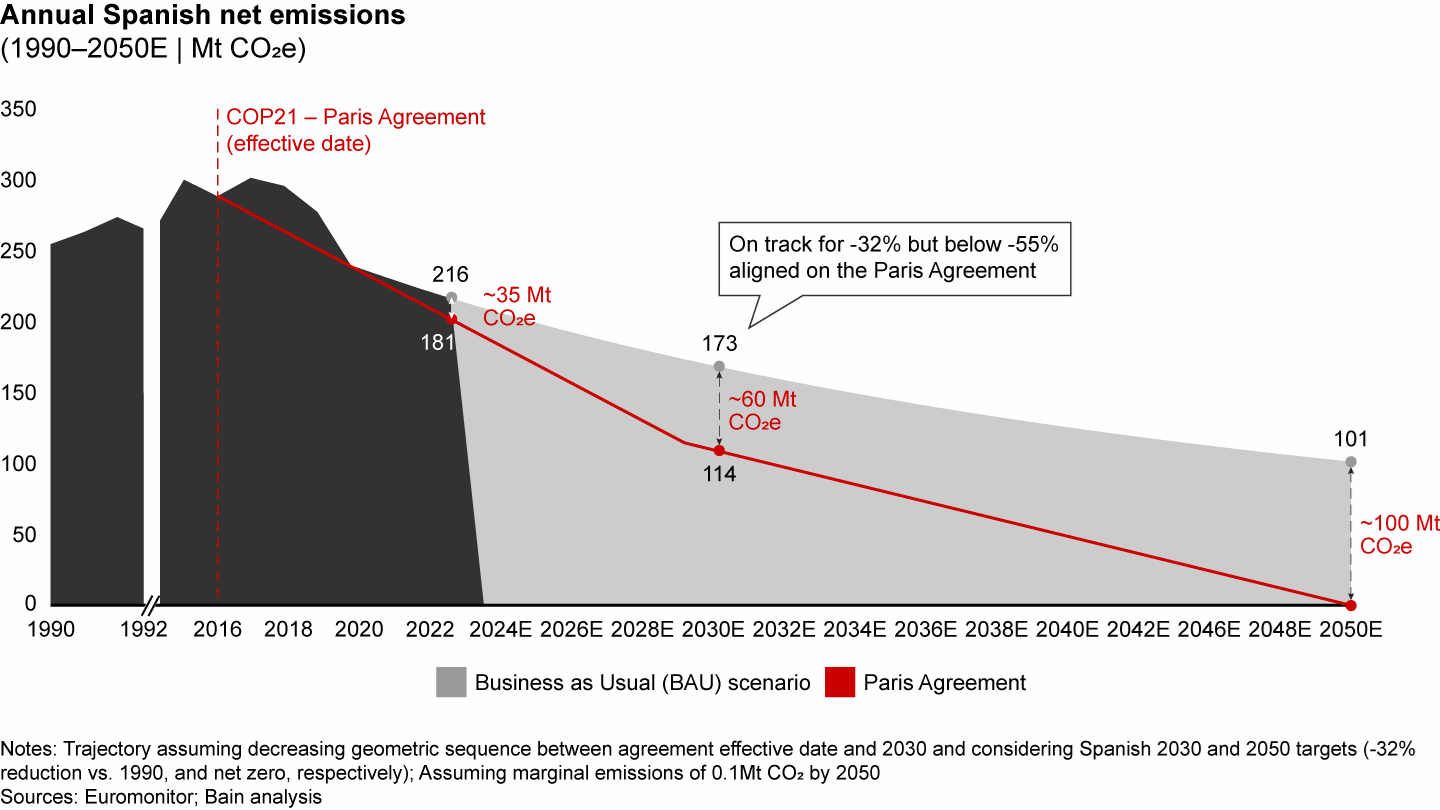
“We believe that Spain is in a relatively favorable position,” says Eugenio Solla, director of sustainability at CaixaBank.
However, he adds: “To achieve greater success, we need stable and global regulatory frameworks and agile resource allocation, supported by state aid. These frameworks will provide the certainty needed for companies to make investments, as this transition involves a significant restructuring of many industries simultaneously and accelerated.”
Furthermore, says Lara de Mesa, group executive vice president and head of responsible banking at Santander, “A clear roadmap for achieving net emissions targets would align actions and provide signals to economic agents. This could be done by strengthening the National Integrated Energy and Climate Plan on this direction.”
Without credible decarbonization frameworks, she says, “Individual behavior change will remain elusive, impeding progress. Reaching net emissions goals require clear signals that incentivize actions for alignment.”
Concerns over Spain’s decarbonization plans
Acknowledging these concerns, Spain’s Ministry for Ecological Transition and Demographic Challenge has proposed an accelerated scenario to achieve net zero by 2050. The proposal is aggressive, looking to accelerate decarbonization by 9 to 12 times the current trend, based on Bain analysis.
However, Bain analysis and private sector opinion raise doubt over the viability of the plan on several fronts. The first is the fact that Spain’s corporate emitters lack a clear baseline of emissions today, and few have a clear view of where they need to get to on decarbonization.
“From a public sector perspective, there is a view that anything is possible and the goal of Spain being net zero by 2050 is in sight,” says Cristina Riestra López, head of the environment and climate area at CEOE, the Spanish confederation of employers’ organizations.
“However, in the private sector things are not so clear. We need to consider the situation of each sector.”
Of 267 Mt CO2e of estimated gross Spanish emissions in 2021, roughly a quarter came from private individuals. Of the remaining 198 Mt CO2e of gross corporate emissions, only 30%—equal to 59.8 Mt CO2e—was disclosed through CDP (formerly the Carbon Disclosure Project), a charity that runs a global disclosure system for investors, companies, cities, states, and regions (see Figure 4).
Scope 1 and 2 emissions by companies with declared ambitions operating in Spain in 2021, in Mt CO2e

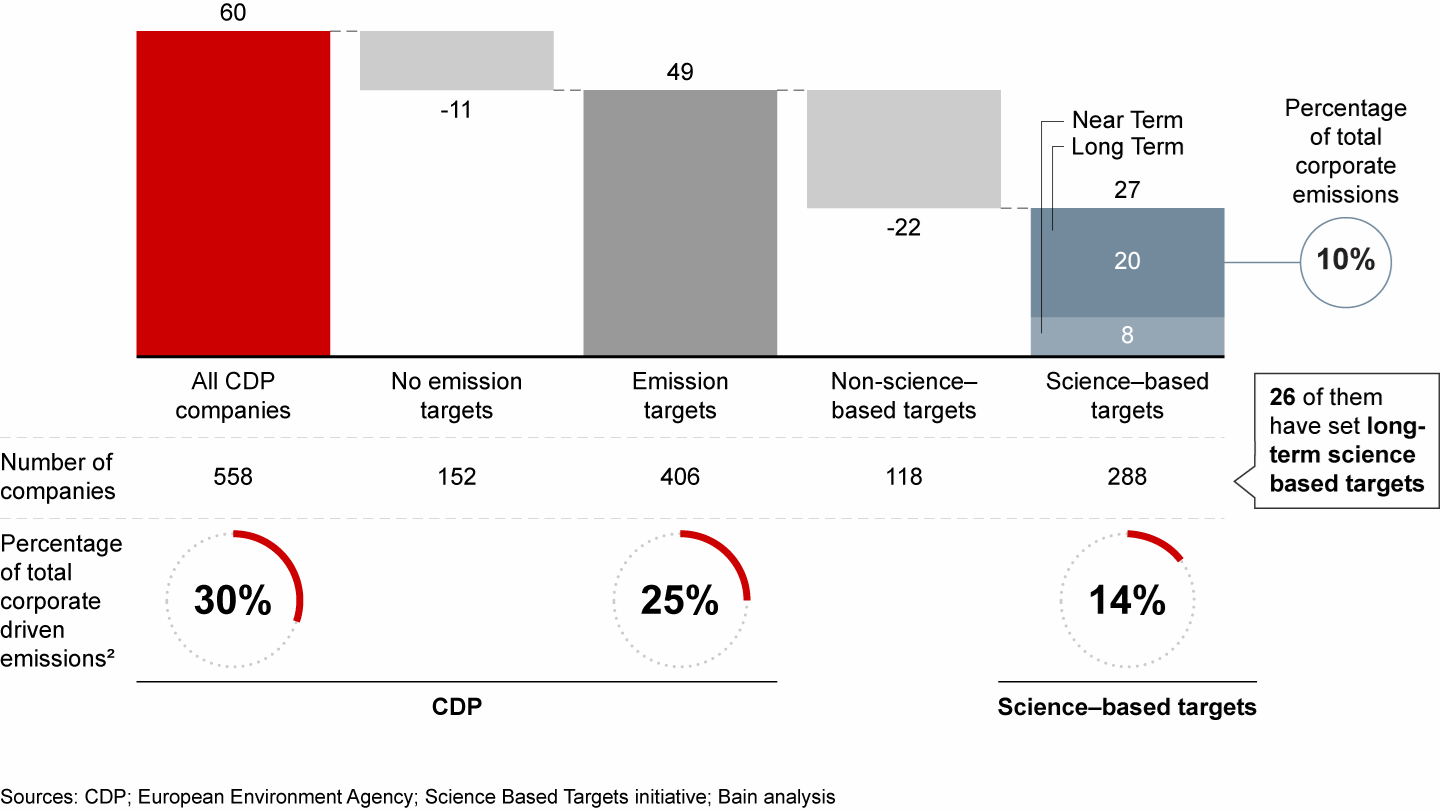
Of the 558 companies disclosing emissions through CDP, 152 had no targets for reduction. A further 118 had targets that were not science based. Thus, in 2021 only 288 companies in Spain, responsible for only 14% of corporate emissions, had science-based targets (SBTs) for carbon reduction.
Corporate leaders note that this is in part because of the complexity of reporting emissions and meeting targets. “Reporting can be quite challenging due to several factors,” says Alfonso de la Lastra, head of the sustainability strategy team at Spanish lender BBVA.
“Firstly, the measurements involved can be complex, and secondly, there’s often public scrutiny that may not always align with positive goals.”
A second issue with the Spanish plan is the magnitude of the acceleration involved. “Achieving net zero is an immense challenge for any company or country,” says Alex Dilme, strategy and sustainability director at GBFoods, a food industry firm.
“It’s evident that companies alone cannot drive this transformation, as cost sensitivity among consumers and the industry’s pace of change present formidable obstacles. To succeed, regulation and government support will be indispensable in orchestrating the transformation.”
The level of investment required to achieve this acceleration is daunting. Bain analysis indicates it could cost up to around €2 trillion (see Figure 5).
Reaching net zero by 2050 would require a sizeable public-corporate-private investment

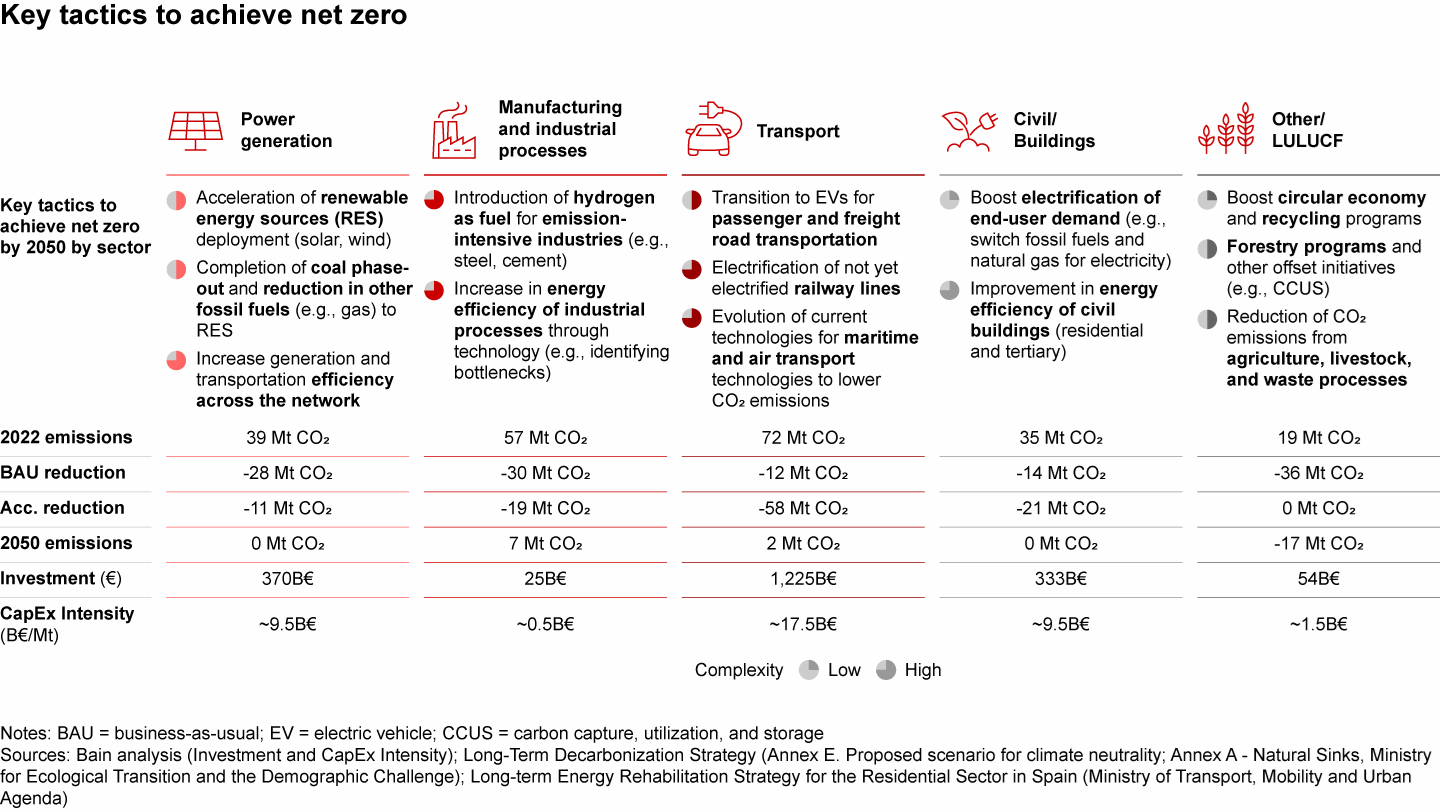
Clara Rey, sustainability director at Repsol, a major Spanish energy company, acknowledges: “Our goal of achieving net-zero emissions by 2050 is ambitious. While we have clear levers and see their impact in the short term, their contribution in the long term is not entirely clear due to the high technological and regulatory uncertainty.”
According to Bruno Martínez Falagan, the director of environment at major brewery Mahou San Miguel, “One of the main challenges is making decisions and establishing concrete plans in an environment with such high regulatory, technological, and price uncertainties over long-term horizons. It’s very important to generate long-term security.”
Spain’s climate goals will require a major commitment from corporations and individuals, and coordinated action across a range of sectors, including:
- Power generation, where the government estimates renewables will have to go from 59% of new installed capacity in 2022 to 100% by 2050, and from 42% of final energy consumption last year to 97% by mid-century. Meanwhile, energy imports will need to drop from 71% in 2020 to 13% by 2050.
- Manufacturing and industrial processes, which will require new supplies of biogas, biomethane, and low-carbon hydrogen to fuel emissions-intensive industries while increasing the efficiency of production to achieve a 5% cut in emissions.
- Transport, where the Spanish government foresees road and rail undergoing extensive electrification. Bain’s energy practice believes aviation and shipping may opt for low-carbon fuels, such as biofuels, to reduce emissions.
- Construction, which the administration forecasts will need to achieve a 98% reduction in emissions for residential housing by 2050, along with a 37% cut in energy consumption.
Emissions associated with land use, land-use change, and forestry (LULUCF) are seen as being hard to mitigate in Spain, with no plans for change (see Figure 6).
Ministry for Ecological Transition and Demographic Challenge proposals for an accelerated scenario to bridge the gap to net zero by 2050

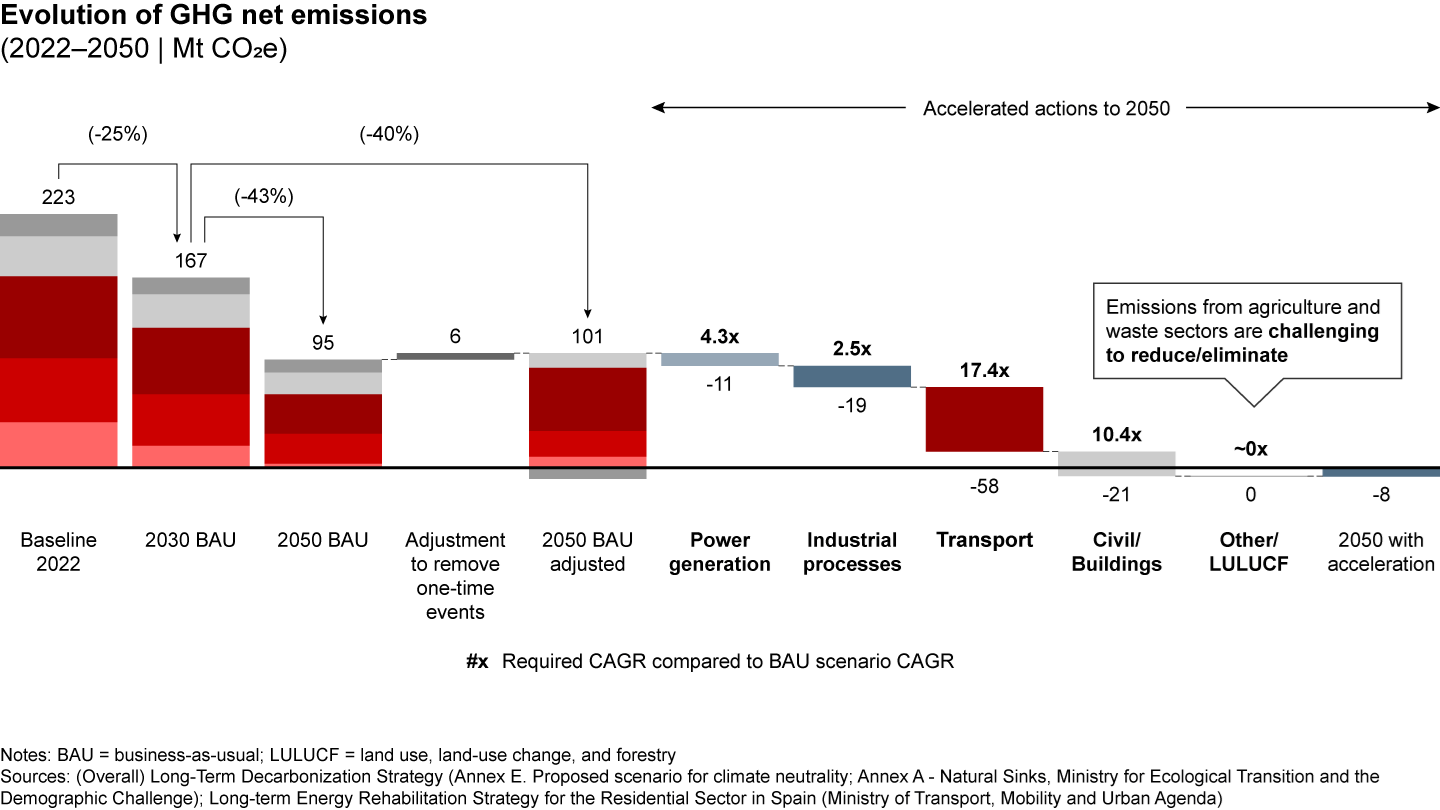
A growing source of risk
Lack of clarity on goals and pathways is increasingly at odds with the stable environment required for business growth in Spain. The country’s annual temperatures have risen 1.4 degrees Celsius above a 1990 baseline (see Figure 7).
Regarding adaptation, Spain faces significant physical risks


A range of important climate risks have accompanied this rise in average temperature. From 1990 to 2022, for example:
- The frequency of cyclones has risen by 25%, with a major event now happening every couple of years.
- Wildfires have increased, burning 54% more land, up to 306,000 hectares a year from 199,000.
- Spain has lost seven days of rain a year and experienced five intense droughts since 1990.
- The frequency of heat waves has risen 242%, to an average 41 per year from 12.
These climate shifts are already having a measurable impact on corporate operations in Spain.
Switching to adaptation
The need for adaptation is set to rise in line with a worsening climate outlook, with the area of Spain exposed to physical risks rising from 58% today to 79% by 2050 (see Figure 8).
Geolocalized assessment of physical risk exposure in Spain

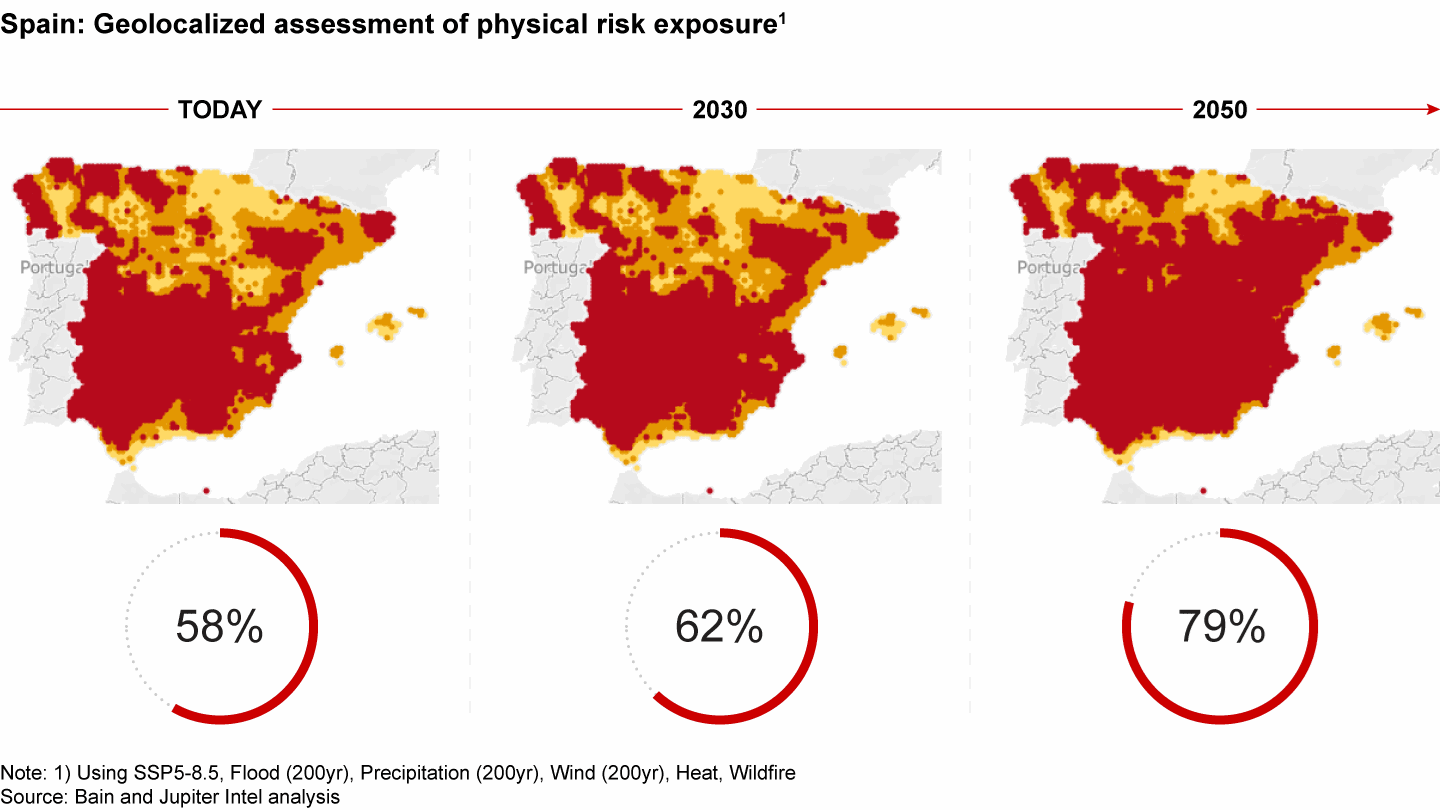
This worsening climate outlook is forcing leaders to put special plans in place.
Martínez of Mahou San Miguel says, “We work in different time horizons to mitigate water risk, reducing consumption through more efficient operations, and adapting facilities with new investments. Water regeneration must play a much more relevant role in the future. On the other hand, we will work with our suppliers to promote regenerative agriculture and new, more resistant varieties.”
A Bain & Company analysis with Jupiter, a leading provider of predictive data and analytics for climate risk management and resilience, shows global warming impacts could hammer the Spanish economy with a cumulative average annual loss of around €21 billion by 2050.
The analysis shows industrial players and banking and professional services operations being most at risk from either the impact on operational costs of increased heating and cooling requirements or rebuilding expenses from damage caused by continuous or extreme hazards (see Figure 9).
Cumulative average annual loss (AAL) in billions of euros, from 2020 to 2050)

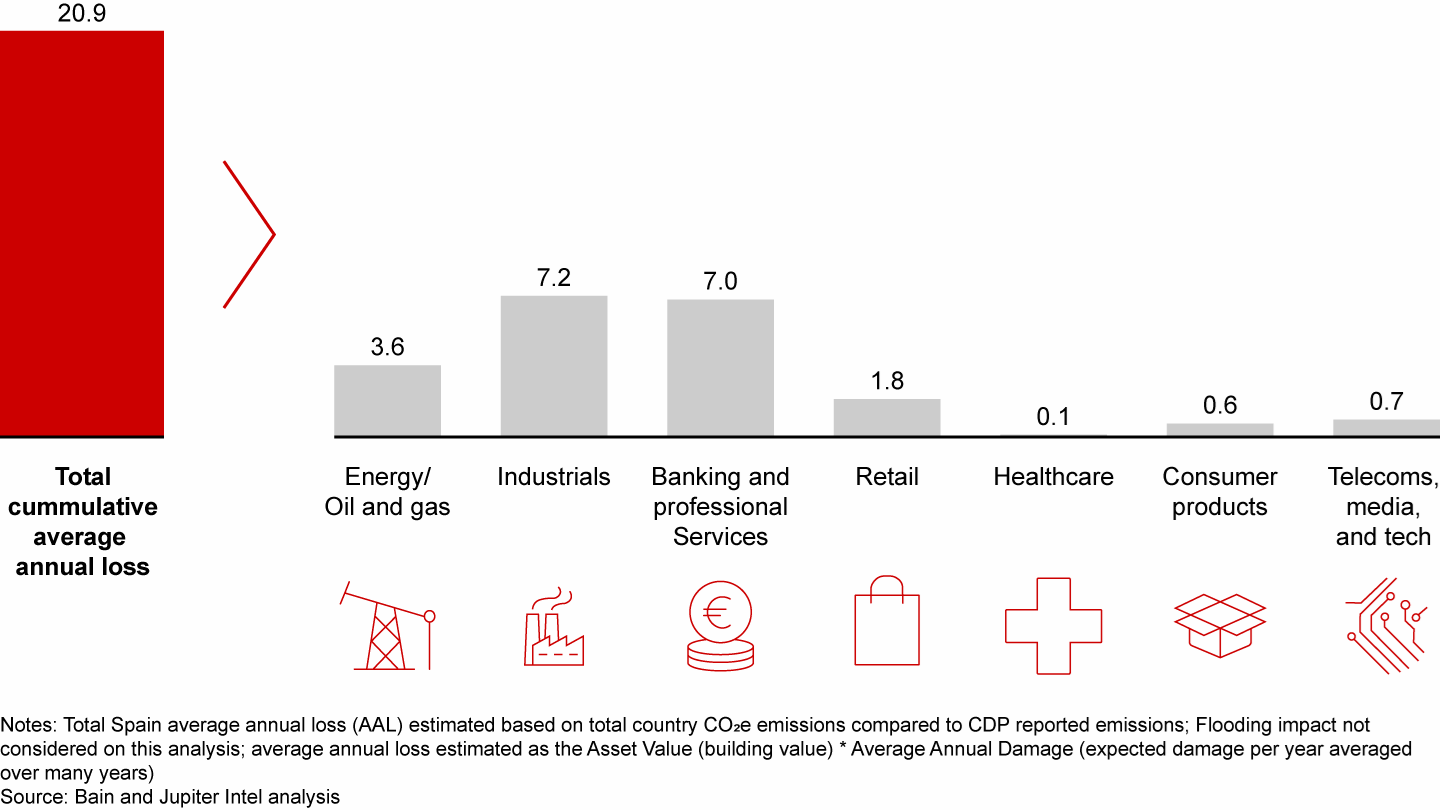
The Spanish government has recognized the need to contain adaptation costs, implementing 2030 targets linked to key performance indicators on climate, implementing national policies and action plans, and increasing funds and incentives.
However, for effective climate risk management, corporations need precise data and bureaucracy-free incentives, according to business leaders.
The need for collaboration
The scale of Spain’s growing climate crisis is such that government alone cannot be expected to provide all the answers—and nor can the private sector. Instead, public and private actors will all play pivotal roles in meeting Spain’s climate targets, working together to help limit temperature rise.
“In Spain, authorities assume that companies would already be reporting emissions, although this is not the case,” says Riestra at CEOE. “According to a CEOE survey, only 20.3% register their carbon footprint, and if you look in detail at large companies, only 5% do so.”
This has not stopped smaller corporate players from reducing their carbon footprints without declaring emissions, she adds, although they do not currently gain much from doing so. The incentive is reputational.
A major problem is the lack of information that companies face in terms of reporting methods, advantages, future opportunities, and so on, Riestra says.
“Traditionally, sustainability has been a secondary issue,” she says. “It is only now that it is being escalated to management as it is having a direct impact on business and costs.”
Government agencies and regulators will need to coordinate the energy transition with a clear plan that turns a global vision into specific goals for each sector, using the tax system to encourage companies and individuals to reach zero emissions.
The public sector will also have to make sure that emission and decarbonization reporting plans adapt to the actual state of industries, enabling better monitoring of their transformation progress from the ground up.
It would also help to have a common regulatory reporting framework, rather than the multiple methodologies in use today.
At the same time, the administration must create more effective ways to allocate resources to society and speed up the transition, and establish transparent, adaptable, stable, and financially supportive regulations as a key driver for accelerating change.
“Regulation should serve as an incentive rather than a penalty,” says Antonio López, head of energy transition and climate at Repsol. “When you ban certain levers, you close the door to potential solutions that could be available to drive a less expensive energy transition.”
In the private sector, meanwhile, responses to the climate crisis may vary by sector, as follows:
- Financial services players should enable the decarbonization of high-polluting portfolios by redefining funding to meet emissions intensity targets, acting as change agents, helping government channel funds more effectively, and investing in data analysis to identify risks and opportunities.
- Energy companies should cut CO2 in the generation mix, enhance energy efficiency, adapt infrastructure to climate risks, ensure widespread electricity access, embrace renewable fuels, and deploy carbon capture technologies if there is a risk of missing net zero targets.
- Agricultural producers should improve energy and water efficiency and embrace regenerative agriculture, while reducing emissions and promoting ecosystem conservation through sustainable practices, such as efficient fertilizer use and biodiversity management.
- Consumer products manufacturers should foster collaboration to drive change, ensure sustainability plans translate to value, enhance relationships with suppliers, and implement climate adaptation measures to safeguard supply chains.
- Retailers should encourage the reduction of Scope 3 emissions through financial incentives such as discounts.
Efforts to limit climate impacts will hopefully have cascading effects on individuals in terms of increased demand for sustainability and more sustainable behaviors, such as avoiding waste, which in turn will stimulate more sustainable business practices.
However, for this virtuous feedback loop to be effective, corporations and government entities in Spain will have to work hand in hand rather than expecting each other to take the lead.